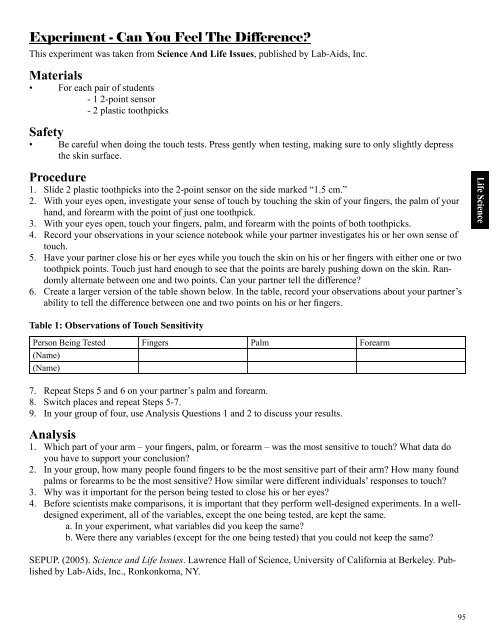ScienceMakers Toolkit Manual - The History Makers
ScienceMakers Toolkit Manual - The History Makers
ScienceMakers Toolkit Manual - The History Makers
Create successful ePaper yourself
Turn your PDF publications into a flip-book with our unique Google optimized e-Paper software.
Experiment - Can You Feel <strong>The</strong> Difference?<br />
This experiment was taken from Science And Life Issues, published by Lab-Aids, Inc.<br />
Materials<br />
• For each pair of students<br />
- 1 2-point sensor<br />
- 2 plastic toothpicks<br />
Safety<br />
• Be careful when doing the touch tests. Press gently when testing, making sure to only slightly depress<br />
the skin surface.<br />
Procedure<br />
1. Slide 2 plastic toothpicks into the 2-point sensor on the side marked “1.5 cm.”<br />
2. With your eyes open, investigate your sense of touch by touching the skin of your fi ngers, the palm of your<br />
hand, and forearm with the point of just one toothpick.<br />
3. With your eyes open, touch your fi ngers, palm, and forearm with the points of both toothpicks.<br />
4. Record your observations in your science notebook while your partner investigates his or her own sense of<br />
touch.<br />
5. Have your partner close his or her eyes while you touch the skin on his or her fi ngers with either one or two<br />
toothpick points. Touch just hard enough to see that the points are barely pushing down on the skin. Randomly<br />
alternate between one and two points. Can your partner tell the difference?<br />
6. Create a larger version of the table shown below. In the table, record your observations about your partner’s<br />
ability to tell the difference between one and two points on his or her fi ngers.<br />
Table 1: Observations of Touch Sensitivity<br />
Person Being Tested Fingers Palm Forearm<br />
(Name)<br />
(Name)<br />
7. Repeat Steps 5 and 6 on your partner’s palm and forearm.<br />
8. Switch places and repeat Steps 5-7.<br />
9. In your group of four, use Analysis Questions 1 and 2 to discuss your results.<br />
Analysis<br />
1. Which part of your arm – your fi ngers, palm, or forearm – was the most sensitive to touch? What data do<br />
you have to support your conclusion?<br />
2. In your group, how many people found fi ngers to be the most sensitive part of their arm? How many found<br />
palms or forearms to be the most sensitive? How similar were different individuals’ responses to touch?<br />
3. Why was it important for the person being tested to close his or her eyes?<br />
4. Before scientists make comparisons, it is important that they perform well-designed experiments. In a welldesigned<br />
experiment, all of the variables, except the one being tested, are kept the same.<br />
a. In your experiment, what variables did you keep the same?<br />
b. Were there any variables (except for the one being tested) that you could not keep the same?<br />
SEPUP. (2005). Science and Life Issues. Lawrence Hall of Science, University of California at Berkeley. Published<br />
by Lab-Aids, Inc., Ronkonkoma, NY.<br />
95<br />
Life Science










